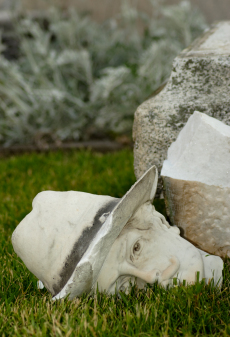 I ran this post last year at this time and thought it would be appropriate to share it again given the increased number of news items purporting to point out the first memorial day celebaration.
I ran this post last year at this time and thought it would be appropriate to share it again given the increased number of news items purporting to point out the first memorial day celebaration.
It is probably safe to assume that as we approach Memorial Day Weekend we will see an increase in stories purporting to demonstrate the origin of this commemoration. Even as we emphasize our nationalistic zeal our fascination with the old saw of North v. South will be highlighted for our reading pleasure. No doubt the question will be framed in terms of when white Americans gathered to commemorate the first memorial day. Little thought will be given to the possibility that our tendency to see the Civil War as a white man’s war is both too narrow and overly simplistic. I first came across the story of how black Charlestonians commemorated Union soldiers buried in a local race track in David Blight’s Race and Reunion, and I recently came across the story again in the on-line journal Common-place by the same author.
After Charleston, South Carolina was evacuated in February 1865 near the end of the Civil War, most of the people remaining among the ruins of the city were thousands of blacks. During the final eight months of the war, Charleston had been bombarded by Union batteries and gunboats, and much of its magnificent architecture lay in ruin. Also during the final months of war the Confederates had converted the Planters’ Race Course (a horse track) into a prison in which some 257 Union soldiers had died and were thrown into a mass grave behind the grandstand.
In April, more than twenty black carpenters and laborers went to the gravesite, reinterred the bodies in proper graves, built a tall fence around the cemetery enclosure one hundred yards long, and built an archway over an entrance. On the archway they inscribed the words, “Martyrs of the Race Course.” And with great organization, on May 1, 1865, the black folk of Charleston, in cooperation with white missionaries, teachers, and Union troops, conducted an extraordinary parade of approximately ten thousand people. It began with three thousand black school children (now enrolled in freedmen’s schools) marching around the Planters’ Race Course with armloads of roses and singing “John Brown’s Body.” Then followed the black women of Charleston, and then the men. They were in turn followed by members of Union regiments and various white abolitionists such as James Redpath. The crowd gathered in the graveyard; five black preachers read from Scripture, and a black children’s choir sang “America,” “We Rally Around the Flag,” the “Star-spangled Banner,” and several spirituals. Then the solemn occasion broke up into an afternoon of speeches, picnics, and drilling troops on the infield of the old planters’ horseracing track.
This was the first Memorial Day. Black Charlestonians had given birth to an American tradition. By their labor, their words, their songs, and their solemn parade of roses and lilacs and marching feet on their former masters’ race course, they had created the Independence Day of the Second American Revolution.
To this day hardly anyone in Charleston, or elsewhere, even remembers this story. Quite remarkably, it all but vanished from memory. But in spite of all the other towns in America that claim to be the site of the first Memorial Day (all claiming spring, 1866), African Americans and Charleston deserve pride of place. Why not imagine a new rebirth of the American nation with this scene?
It is easy to see how such an event could be lost during the postwar period as white Americans chose to ignore the theme of emancipation and in its place substituted a narrative that could more easily bring about sectional reunion. The remembrance of such events, however, challenges those who continue to downplay or ignore entirely the role that slavery played in the secession debates and the eventual outcome of the war itself. Regardless of whether we choose to remember these central themes, black Americans clearly did view the war along these lines. And that is not up for debate.
Samuel, — Thanks for the positive feedback. I read with interest your story on Memorial Day though I have to admit to not understanding at all the point of it all. There seemed to be nothing historical about the lesson; rather, it was all about reducing the kids’ perspective on this important day to one of guilt.
http://lincolnstudies.blogspot.com/2007/05/memorial-day.html
I really enjoyed this post, great story from a fantastic book.
Sam.